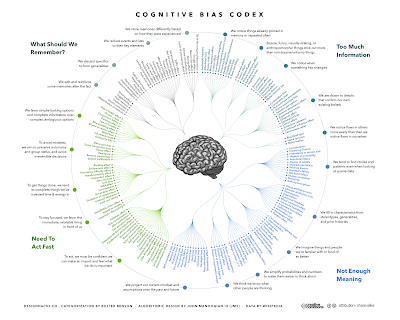They say that your mind can play tricks on you, but this is
ridiculous.
Are you thinking of a cognitive bias, but you can’t recall
its name? Do you ever suspect fallacious thinking, but can’t diagnose its
cause? Sure, we’ve all been there.
But now there’s no need to struggle with
floppy flash cards or your fallible memory. Now there’s the Cognitive Bias Codex! This handy-dandy website and graphic presents, like, ALL of the
cognitive biases, helpfully organized by cause.
Got information overload? Maybe you are “anchoring” or
suffering from “post-purchase rationalization.”
Not exciting enough for you? There’s also the “cheerleader
effect,” the “masked man fallacy,” and even the “endowment effect.” Who said
college was boring?
And these are just some of the more than 150 disquietingly
common mistakes your brain can make!
They’re all here!
Brace for impact folks. Everything you thought you knew is a
lie!
All kidding aside, this is a really useful piece of
scholarship. This website and graphic contain a comprehensive list of cognitive
biases, tricks your mind can play on you which create false impressions and
interpretations that can have serious negative effects. Learn them; know them;
live better.
Click on the image for the full sized version.
Works Cited:
Manoogian, John. “Cognitive Bias Codex 2016.” found at Betterhumans.coach.me.
Sep. 2016. Web. 22 Jan. 2018.
Works Referenced:
Benson, Buster. “the Cognitive Bias Cheat Sheet: Because Thinking
is Hard.” Betterhumans.coach.me. 1
Sep. 2016. Web. 22 Jan. 2016.
Note: the
above websites are associated with the parent website Medium.com. This website apparently
provides no sponsor information about itself, so that information is missing
from the MLA citations.



